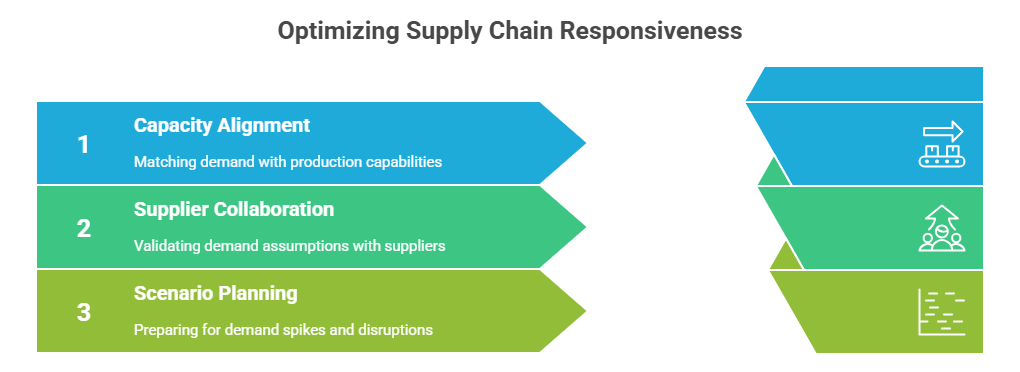How Operations Management Shapes Supply Chains: Planning & Scheduling
Every decision you make in operations sends ripples across the supply chain. The way you plan demand, build forecasts, and schedule production determines not only whether commitments are met, but also how efficiently resources are used and how resilient the supply chain becomes.
The challenge is that these decisions are made in an environment of constant pressure: shifting customer priorities, unpredictable supplier performance, and finite capacity on your shop floor. Navigating these forces requires more than managing today’s workload. It requires a system that connects demand, capacity, and scheduling into a single view so you can act with confidence.
Let’s pick an industry like aerospace and defense to explore the three areas where operations leaders make the greatest impact: demand planning, forecasting, and finite scheduling.
Demand Planning: Aligning Supply with Real Needs
In aerospace and defense, demand planning is the foundation of program execution. Whether you are coordinating parts for a multi-year aircraft program or balancing spares for defense contracts, the ability to align supply with true demand determines how well your supply chain functions.
The difficulty lies in volatility. Contract awards shift, budgets are revised, and urgent defense orders can appear without warning. If demand planning is not directly connected to capacity, you risk promising what cannot be delivered or stockpiling expensive inventory that ties up capital and risks obsolescence. Practical guidance:
- Connect demand planning directly to finite production capacity so that commitments reflect what your machines and workforce can realistically handle.
- Collaborate with strategic suppliers to validate demand assumptions for long-lead items such as titanium alloys or avionics systems.
- Use scenario planning to model demand spikes from sudden contract wins and ensure the supply chain can respond without derailing existing schedules.

Strong demand planning is not about locking in a perfect plan once. It is about continuously synchronizing contract-driven demand with the realities of constrained capacity.
Forecasting: Preparing for Uncertainty
Forecasting in aerospace and defense carries a unique weight. Multi-year projects mean forecasts are often based on long-range government budgets or global defense priorities. Yet programs cannot afford to wait for perfect clarity, operations leaders must prepare for uncertainty.
Take the case of a fighter jet assembly program. Forecasts must anticipate current build schedules, long-lead materials, spare parts demand, and the potential impact of political decisions on funding. Producing too few components risks contract penalties. Producing too many ties up millions of dollars in unused inventory.
Forecasting is also about resources. A shortage of certified machinists or delays from a critical composite supplier can derail a forecast just as much as shifts in customer demand. Practical guidance:
- Blend historical program data with current contract signals to build forecasts that adapt as conditions change.
- Incorporate supplier readiness and labor availability into forecasts, not just material demand.
- Track forecast accuracy against actual results from past programs to refine future assumptions.
In a world where uncertainty is the only constant, disciplined forecasting gives you a structured way to prepare your supply chain without wasting capital or capacity.

Finite Scheduling: Executing with Precision
If demand planning sets direction and forecasting prepares for uncertainty, finite scheduling ensures execution. In aerospace and defense, where bottlenecks are the norm, schedules that ignore real constraints create commitments that collapse when reality hits.
Consider composite curing autoclaves, which often have limited availability and long cycle times. If schedules assume infinite capacity, orders will stack up with no way to process them. Or think of skilled labor: without accurate scheduling, a shortage of certified welders can halt an entire production line.
Finite scheduling respects every constraint you face. It accounts for downtime, setup times, labor availability, and material readiness. By sequencing jobs to prioritize bottleneck resources and minimize wasted time, you create schedules that are achievable and resilient. Practical guidance:
- Identify critical bottlenecks such as autoclaves, machining centers, or specialized labor pools, and build schedules around them.
- Sequence high-priority defense contracts first to ensure delivery commitments are met without creating bottlenecks downstream.
- Maintain real-time visibility into the schedule so adjustments can be made when a supplier delay or urgent contract change occurs.
Finite scheduling is not about rigidity. It is about precision. It gives you the clarity to deliver on commitments while maximizing the use of every constrained resource.
Bringing It Together
Demand planning, forecasting, and finite scheduling are not separate disciplines. They are interdependent levers that determine the strength of your supply chain. When aligned, they create a system that is resilient, efficient, and predictable. When disconnected, they create friction, wasted effort, and broken commitments.
Advanced planning and scheduling (APS) systems provide the integration needed to bring these elements together. By synchronizing demand with capacity, aligning forecasts with actual schedules, and running “what-if” scenarios, APS gives operations leaders the ability to act with foresight rather than constantly reacting to crises.

The Future of Operations Leadership
The complexity of aerospace and defense will only grow. Programs will expand across global suppliers, demand signals will remain uncertain, and capacity constraints will persist. Success will not come from chasing efficiency alone, but from building systems that connect demand planning, forecasting, and finite scheduling into a single, reliable flow.
The future belongs to operations leaders who master this balance. By focusing on these three areas, you not only keep production moving, you create supply chains that are more responsive, more resilient, and better prepared for what comes next.
Ready to see how APS can bring demand planning, forecasting, and finite scheduling into alignment? Request a demo and explore how smarter scheduling can strengthen your operations.